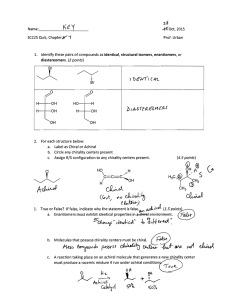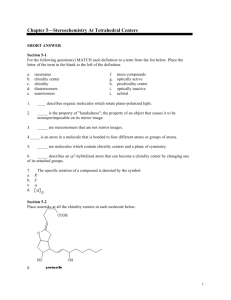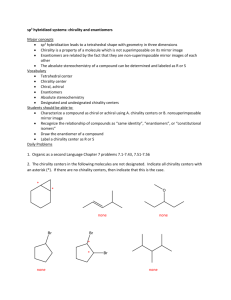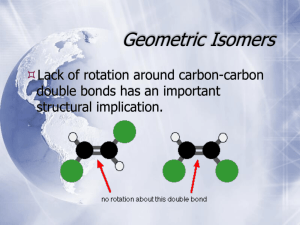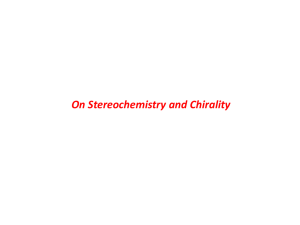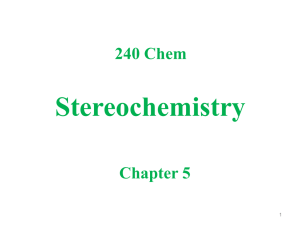Document 13496424
advertisement
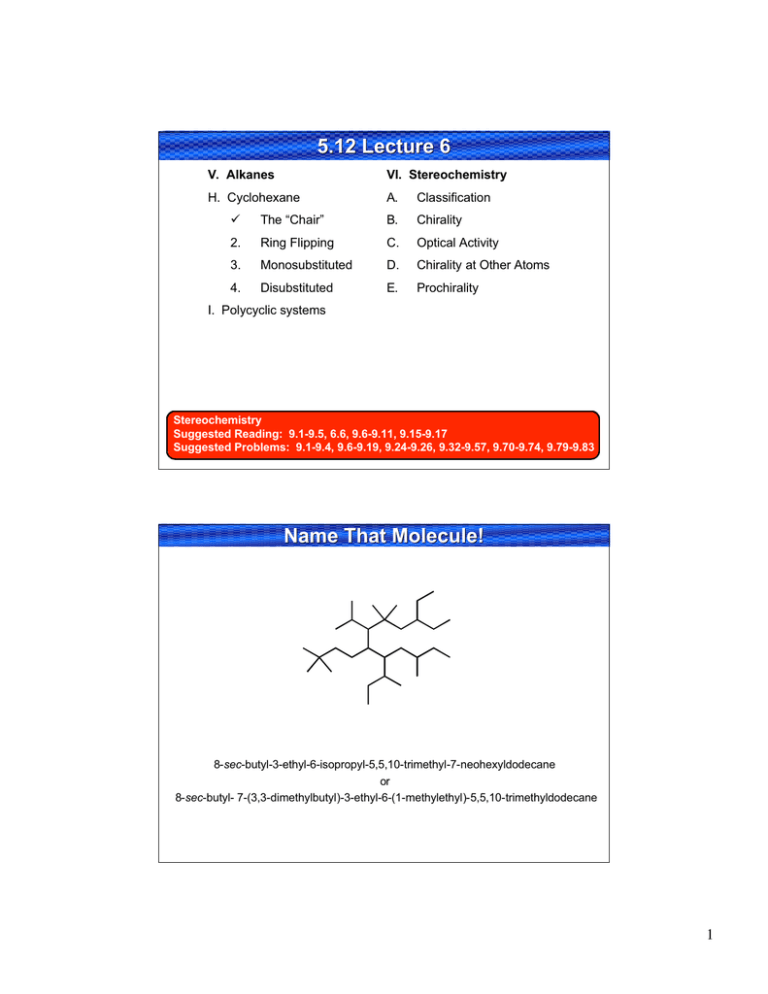
5.12 Lecture 6 6 V. Alkanes VI. Stereochemistry H. Cyclohexane A. Classification • The “Chair” B. Chirality 2. Ring Flipping C. Optical Activity 3. Monosubstituted D. Chirality at Other Atoms 4. Disubstituted E. Prochirality I. Polycyclic systems Stereochemistry Suggested Reading: 9.1-9.5, 6.6, 9.6-9.11, 9.15-9.17 Suggested Problems: 9.1-9.4, 9.6-9.19, 9.24-9.26, 9.32-9.57, 9.70-9.74, 9.79-9.83 Name That Molecule! Molecule! 8-sec-butyl-3-ethyl-6-isopropyl-5,5,10-trimethyl-7-neohexyldodecane or 8-sec-butyl- 7-(3,3-dimethylbutyl)-3-ethyl-6-(1-methylethyl)-5,5,10-trimethyldodecane 1 VI. Stereochemistry Stereochemistry A. Classification of Stereoisomers 1. 2. B. Chirality Conformational 1. Definition a. Bond rotation 2. Determining chirality b. Ring flip 3. Origins of chirality c. Nitrogen inversion a. Carbon with 4 diff. subst. Configurational b. Axial chirality a. Cis-trans c. Meso compounds b. 4 different subst. on carbon c. Subclasses of a) and b) C. Optical Activity i. Enantiomers D. Chirality at Other Atoms ii. Diastereomers E. Prochirality 4. Facts about Chirality Classifying Stereoisomers Stereoisomers Courtesy of Jeffrey S. Moore, Department of Chemistry, University of Illinois at Urbana-Champaign. Used with permission. Adapted by Kimberly Berkowski. 2 Classifiying Stereoisomers: Stereoisomers: Example 1 1 Courtesy of Jeffrey S. Moore, Department of Chemistry, University of Illinois at Urbana-Champaign. Used with permission. Adapted by Kimberly Berkowski. Classifying Stereoisomers: Stereoisomers: Example 2 2 Courtesy of Jeffrey S. Moore, Department of Chemistry, University of Illinois at Urbana-Champaign. Used with permission. Adapted by Kimberly Berkowski. 3 Classifying Stereoisomers: Stereoisomers: Example 3 3 Courtesy of Jeffrey S. Moore, Department of Chemistry, University of Illinois at Urbana-Champaign. Used with permission. Adapted by Kimberly Berkowski. Prioritize Using CahnCahn-IngoldIngold-Prelog Rules 1. Look at atoms directly attached to chirality center a) higher atomic number = higher priority b) heavier isotopes = higher priority 2. If no difference at first attached atom, move along the chain until the first point of difference. 3. Multiple-bonded atoms are equivalent to the same number of single-bonded atoms. 4 Assigning Chirality Center Configuration Configuration The configuration of chirality centers can be assigned using “R,S” descriptors. 1. Prioritize substituents with #’s 1-4 following Cahn-Ingold-Prelog Rules 2 3 4 1 2. Orient molecule so substituent of lowest priority (4) is directed back 2 3. Starting from highest priority substituent (1) move to the second highest (2), then to third highest (3) 1 3 Clockwise movement: ___ R S Counterclockwise movement: ___ Determining Chirality Flow Chart achiral yes no mirror plane? no non-identical mirror image? yes chiral zero How many chirality centers? one chiral two or more mirror plane? yes no no achiral (meso) non-identical mirror image? yes chiral 5 Enantiomers and Diastereomers Diastereomers HO H H OH Et S S Me H OH enantiomers R Et Me R HO H diastereomers HO H (2R, 3S) S Et (2S, 3S) diastereomers diastereomers (2R, 3R) H OH Et R S Me HO H enantiomers Me R H OH (2S, 3R) Importance of Chirality Chirality half of all pharmaceuticals are chiral compounds! O (H3C)2HCH2C C C OH CH3 (S)-Ibuprofen (responsible for pain relief) H (S)-Limonene Lemon smell H (R)-Limonene Orange smell 6 Thalidomide Thalidomide • "Wonder drug" synthesized in 1953 & given to pregnant women to treat morning sickness • Available in 46 countries until 1961/1962 (Not USA!) O O O O N HN N O NH O O O (R)-Thalidomide (S)-Thalidomide sedative teratogen teratogen: causes birth defects phocomelia: arrests limb formation • (R)-Thalidomide racemizes under biological conditions (H+) Chirality and Disubstituted Cyclohexane Achiral: Achiral: Cl H Cl Cl Cl H Cl H Cl Cl H H 1,1 (plane of symmetry through C-1 and C-4) H Cl cis-1,3 (plane of symmetry through C-2 and C-5) cis-1,4 (plane of symmetry through C-1 and C-4) trans-1,4 (plane of symmetry through C-1 and C-4) Chiral: Chiral: Cl H H Cl Cl Cl Cl H H H Cl H cis-1,2 trans-1,2 trans-1,3 Cl Cl H H ring-flips to enantiomer Cl Cl H H 7 D. Chirality at Other sp3 Atoms Atoms All tetrahedral atoms have the possibility of being chiral (Si, N, P, S) Pr Et H Me N N Et H Me Et N Me H high energy barrier for inversion chiral rapid inversion low energy barrier achiral R Me P Pr Lone pairs are lowest priority high energy barrier for inversion chiral R E1. Prochirality at Planar sp2 Carbon Prochiral - can be converted from achiral to chiral in a single chemical step (one step removed from chirality) OH H front attack Et Me H (re face) O Me Et H back attack (si face) OH Me H Et R S re face O1 3 Me 2 Et 1. 2. 3. Assign priorities to three substituents. If clockwise, assign face as re If counterclockwise, assign face as si si face 8 E2. Prochirality at Achiral sp3 Carbon Can become chiral by changing one of its attached groups CH3 D H CH3 H H OH CH3 H D OH R OH S prochiral CH3 pro-R H H OH pro-S Fisher Projections (Common in Biology) COOH COOH HO CH3 H HO H COOH HO CH3 H CH3 Fisher Projection view Vertical lines go into the paper Horizontal lines come out of the paper Dos and Don’ts of Fisher Projections 1. Do place atom with the IUPAC numbering of 1 at the top 2. Don’t rotate 90 degrees, changes molecule into enantiomer 3. Do rotate 180 degrees to see different perspective 4. Do hold one atom constant and then rotate the other three clockwise or counterclockwise to put lowest priority on horizontal axis, or in back Advantages of Fisher Projections 1. Simplifies drawing of molecules with multiple stereogenic centers (see D-glucose) 2. Easy to test if molecule is meso 3. Easy to determine R/S 4. Easy to test for enantiomerism CHO H HO OH H H OH H OH CH2OH D-glucose 9 Important Definitions Definitions stereocenter (stereogenic atom): any atom at which the interchange of two groups results in a stereoisomer; usually either a chiral carbon atom or a double-bonded carbon in a cis/trans alkene chirality center: atom holding a set of ligands in a spatial arrangement that is not superimposable on its mirror image; one type of stereocenter chiral atom (asymmetric atom): atom that is bonded to four different groups; a chiral carbon atom is the most common example of a chirality center internal mirror plane: plane that divides molecule in such a way that two halves are identical chiral (optically active): possessing a non-identical mirror image (an enantiomer) achiral: superimposable on its mirror image enantiomers: stereoisomers that are non-identical mirror images (same physical properties) diastereomers: stereoisomers that are not enantiomers (different physical properties) meso compound: achiral molecule that has chirality centers Using the Lingo an atom: • that gives rise to stereoisomers when its substituents are interchanged is a stereocenter • holding a set of ligands in an arrangement that is not superimposable on its mirror image is a chirality center (one type of stereocenter) • with four different substituents attached is a chiral atom (one type of chirality center) • that is chiral uses the R/S descriptors to assign absolute configuration a molecule: • must be either achiral (optically inactive) or chiral (optically active) • that is achiral but contains chirality centers is called a meso compound • that is optically active can be labelled (+/–) or (d/l) related molecules: • enantiomers (non-identical mirror images) • diastereomers (any stereoisomers that are not enantiomers) samples of molecules: • optically pure (only one enantiomer present in sample) • racemate or racemic mixture (mixture containing equal amounts of each enantiomer), not optically active • mixtures in between optically pure and racemic are described by their optical purity (only 1 enantiomer present) or enantiomeric excess (1 enantiomer is in excess) Note: Do not to confuse experimentally derived labels (+/– or d/l) with structurally derived labels (R/S). They are not related! 10
